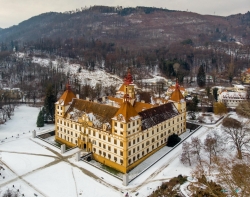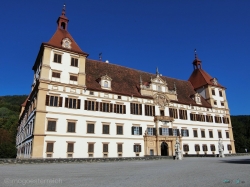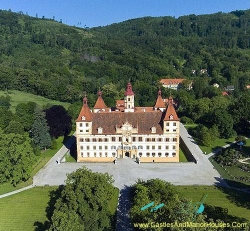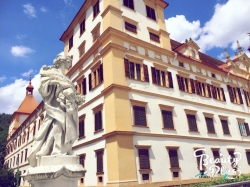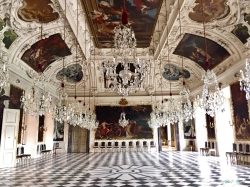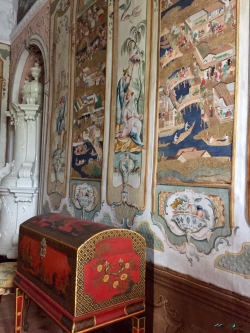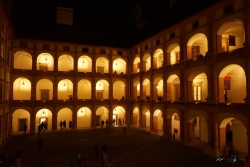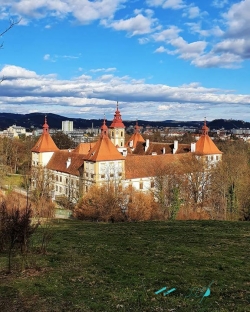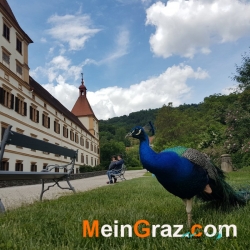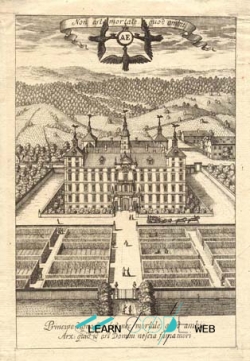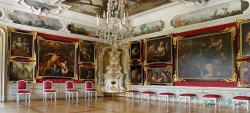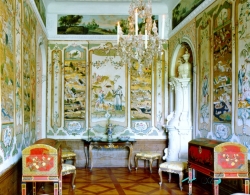Eggenberg Palace in Graz is the largest and most important baroque palace complex in Styria. With its preserved original furnishings, the extensive landscape garden and the collections of the Universalmuseum Joanneum housed in the castle, it is one of Austria's most valuable cultural assets. As the ancestral seat of the Eggenberg family, its history of construction and furnishings shows the change and patronage of what was once the most powerful family in Styria. In 2010 the castle was added to the existing UNESCO World Heritage City of Graz - Historic Center.
The castle is located in the west of the provincial capital Graz at the foot of the Plabutsch mountain. In addition to the historical gardens and the state rooms of the palace, Eggenberg also offers the opportunity to visit the following collections: In the north of the palace park there is the planetary garden and the adjoining archeology museum. The numismatic collection and the old gallery are housed in the castle.
At first glance, Eggenberg Palace presents itself as a unified 17th century building. However, large parts of the building core date from the late Middle Ages and early modern times.
Balthasar Eggenberger bought the Orthof on the Algersdorfer fields between 1460 and 1463. This fortified noble seat was named after the family and was expanded and redesigned in the following years. Before 1470, a square chapel room was set up in the free-standing tower. From this chapel there is a Roman cardinal indulgence, dated May 30, 1470, which gives the capella Beate Marie Virginis sita in Castro Eckenperg certain privileges. This document provides the terminus ante quem for the completion of the chapel. Balthasar donated a magnificent winged altar for this chapel room, the panels of which are now here again at the original installation site.
In the 16th century this, probably L-shaped, late medieval single-tower castle was adapted to the social status of the family and expanded several times. Features of the building that still show parts of these construction phases today are window frames that provide information about the former storey heights, corner cuboids and acanthus-framed bioforic windows and picturesque furnishings in individual rooms. When this building no longer met the requirements of the new princely family, a fundamental renovation began in 1625. The existing, older components were cleverly integrated into the new building: on the one hand, probably because of the preciousness of the building materials, but on the other hand, because of the obvious will not to completely destroy the family's ancestral home. The Gothic Lady Chapel remained unchanged and became the focal point of the new complex.
The castle is located in the west of the provincial capital Graz at the foot of the Plabutsch mountain. In addition to the historical gardens and the state rooms of the palace, Eggenberg also offers the opportunity to visit the following collections: In the north of the palace park there is the planetary garden and the adjoining archeology museum. The numismatic collection and the old gallery are housed in the castle.
At first glance, Eggenberg Palace presents itself as a unified 17th century building. However, large parts of the building core date from the late Middle Ages and early modern times.
Balthasar Eggenberger bought the Orthof on the Algersdorfer fields between 1460 and 1463. This fortified noble seat was named after the family and was expanded and redesigned in the following years. Before 1470, a square chapel room was set up in the free-standing tower. From this chapel there is a Roman cardinal indulgence, dated May 30, 1470, which gives the capella Beate Marie Virginis sita in Castro Eckenperg certain privileges. This document provides the terminus ante quem for the completion of the chapel. Balthasar donated a magnificent winged altar for this chapel room, the panels of which are now here again at the original installation site.
In the 16th century this, probably L-shaped, late medieval single-tower castle was adapted to the social status of the family and expanded several times. Features of the building that still show parts of these construction phases today are window frames that provide information about the former storey heights, corner cuboids and acanthus-framed bioforic windows and picturesque furnishings in individual rooms. When this building no longer met the requirements of the new princely family, a fundamental renovation began in 1625. The existing, older components were cleverly integrated into the new building: on the one hand, probably because of the preciousness of the building materials, but on the other hand, because of the obvious will not to completely destroy the family's ancestral home. The Gothic Lady Chapel remained unchanged and became the focal point of the new complex.



